The iPhone 5 Review
by Anand Lal Shimpi, Brian Klug & Vivek Gowri on October 16, 2012 11:33 AM EST- Posted in
- Smartphones
- Apple
- Mobile
- iPhone 5
General Purpose Performance
Section by Anand Shimpi
Apple's philosophy on increasing iPhone performance is sort of a mix between what Microsoft is doing with Windows Phone 7/8 and what the high-end Android smartphone makers have been doing. On the software side Apple does as much as possible to ensure its devices feel fast, although I notice a clear tendency for newer iOS releases to pretty much require the latest iPhone hardware in order to maintain that speedy feel over the long haul. When it comes to hardware, Apple behaves very much like a high-end Android smartphone vendor by putting the absolute fastest silicon on the market in each generation of iPhone. The main difference here is that Apple controls both the software stack and silicon, so it's able to deliver a fairly well bundled package each year. It's a costly operation to run, one that is enabled by Apple's very high profit margins. Ironically enough, if Apple's competitors would significantly undercut Apple (it doesn't cost $599 - $799 to build a modern smartphone) I don't know that the formula would be able to work for Apple in the long run (Apple needs high margins to pay for OS, software and silicon development, all of which are internalized by Apple and none of which burden most of its competitors).
Good cross platform benchmarks still don't really exist on smartphones these days. We're left describing experience with words and trying to quantify performance differences using web based benchmarks, neither of which is ideal but both of which will have to do for now. The iPhone 5 experience compared to the 4S is best explained as just being snappier. Apps launch faster, scrolling around iOS Maps is smoother, web pages take less time to load and the occasional CPU/ISP bound task (e.g. HDR image processing) is significantly quicker. If you're the type of person who appreciates improvements in response time, the iPhone 5 delivers.
How does it compare to the current crop of high-end Android smartphones? I would say that the 5 generally brings CPU performance up to par with the latest and greatest in the Android camp, and in some cases surprasses them slightly. It's difficult making cross platform comparisons because of huge differences in the OSes as well as separating out tasks that are CPU bound from those that simply benefit from a higher rendered frame rate.
I took a cross section of various web based benchmarks and looked at their performance to help quantify where the iPhone 5 stands in the world. First up are the RIABench focus tests, these are javascript benchmarks that focus on various compute bound tasks. I used Chrome for all Android devices to put their best foot forward.

This first test shows just how slow the 800MHz Cortex A9s in the iPhone 4S were compared to the latest and greatest from Qualcomm and NVIDIA. At roughly half the clock speed of those competitors, the 4S was just much slower at compute bound tasks. Apple was able to mask as much of that as possible with smooth UI rendering performance, but there was obviously room for improvement. The iPhone 5 delivers just that. It modernizes the iPhone's performance and inches ahead of the Tegra 3/Snapdragon S4 platforms. Only Intel's Atom Z2460 in the Motorola RAZR i is able to outperform it.
Next up is Kraken, a seriously heavy javascript benchmark built by Mozilla. Kraken focuses on forward looking applications that are potentially too slow to run in modern browsers today. The result is much longer run times than anything we've seen thus far, and a very CPU heavy benchmark:
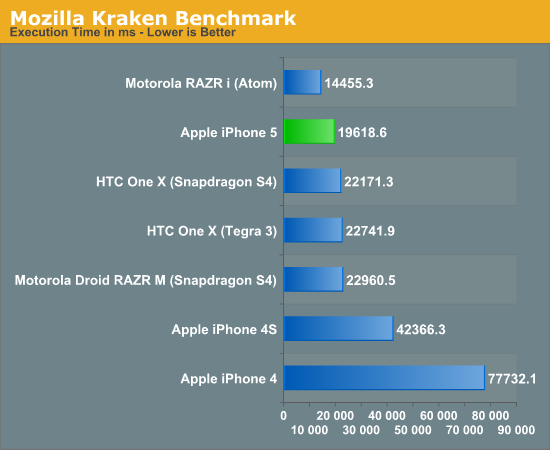
The standings don't change much here. The iPhone 4S is left in the dust by the iPhone 5, which steps ahead of the latest NVIDIA/Qualcomm based Android devices. The Apple advantage here is just over 10%. Once again, Intel's Atom Z2460 pulls ahead with the clear lead.
In our iPhone 5 Performance Preview we looked at Google's V8 javascript test as an alternative to SunSpider. The more data points the merrier:
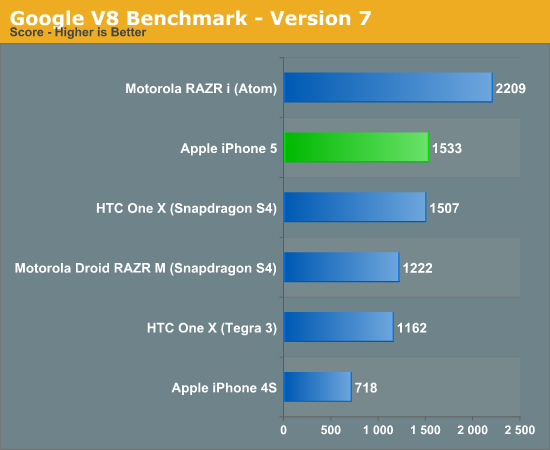
Here the iPhone 5 manages to hold onto its second place position, but just barely. Once more, the Atom based RAZR i maintains the performance lead.
Google's Octane benchmark includes all 8 of the V8 tests but adds 5 new ones including a PDF reader, 3D bullet physics engine and portable 3D game console emulator all built in javascript.
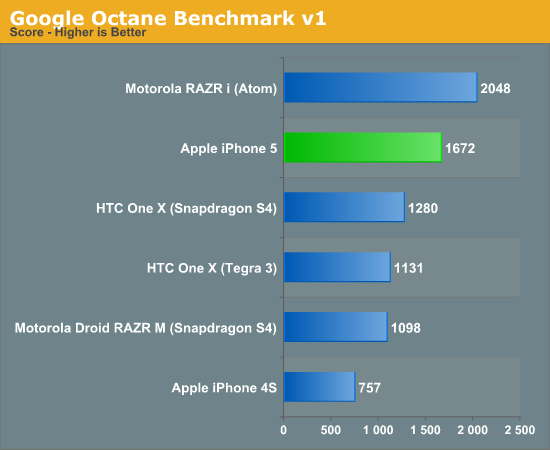
The 5 pulls ahead of the HTC One X here and maintains a healthy 31% lead, but once again falls short of the RAZR i.
We of course included our SunSpider and BrowserMark tests, both of which show the iPhone 5 very favorably:
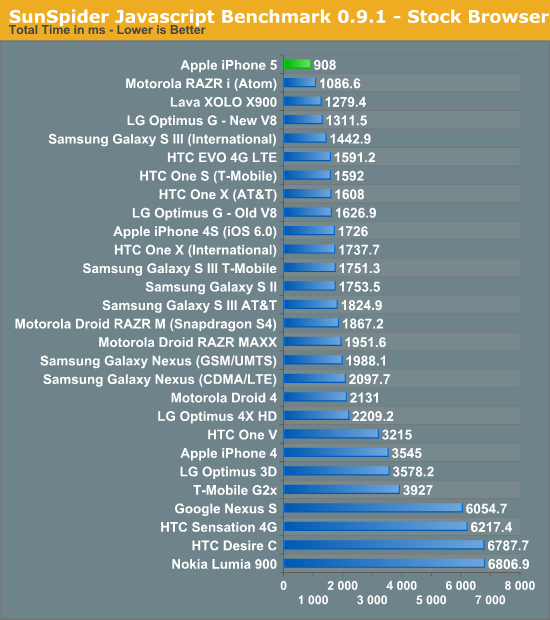
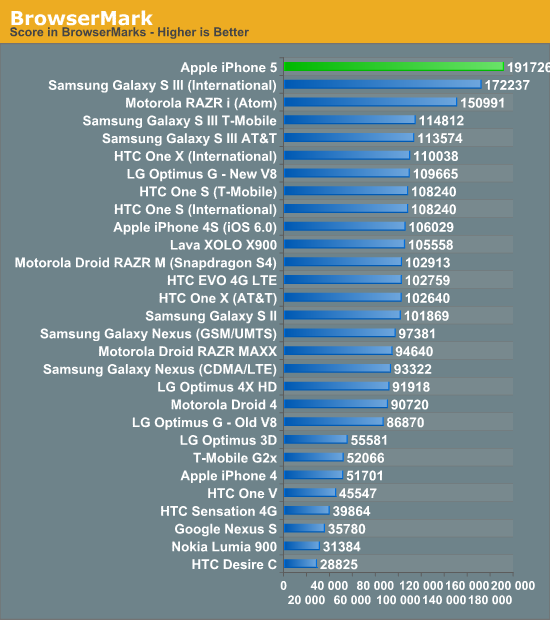
Performance obviously depends on workload, but it's clear the iPhone 5 is a big step forward from the 4S and tends to outperform the latest ARM based Android smartphones. As the rest of the ARM based SoC players move to Cortex A15 designs they should be able to deliver faster devices in the first half of 2013.
Intel's current position when it comes to CPU performance is interesting. A move to a dual-core design could be enough to remain performance competitive with 2013 ARM based SoCs. Remembering that Atom is a 5 year old CPU core that performs at the level of a 10 year old mainstream notebook CPU puts all of this progress in perspective. Intel's biggest issue going forward (other than getting Atom into more tier 1 phone designs) is going to be improving GPU performance. Luckily it seems as if it has the roadmap to do just that with the Atom Z2580.










276 Comments
View All Comments
Zink - Wednesday, October 17, 2012 - link
That's would be light enough to float.manders2600 - Wednesday, October 17, 2012 - link
It would be really nice to see some of these benchmarks next to an Android device running Jellybean.From my personal experience with the Galaxy Nexus, all of the benchmarks run in this article improve dramatically (many by more than 50%) with that OS version.
I'm really curious to see what a comparison between the performance of an S4 (Krait) and an A6 would be in that situation, since so much of the CPU tests are impacted by OS.
manders2600 - Wednesday, October 17, 2012 - link
But great read, though!. . . sorry, forgot to include that.
Tremendous research went into this, and it is well appreciated.
phillyry - Sunday, October 21, 2012 - link
I agree.I mean it's good that you have the devices on their native OSes but showing them on their upgraded OSes would bee good too 'cause it would add another realistic point of comparison.
cjl - Wednesday, October 17, 2012 - link
In the article, you state:"Which brings us to the next key detail with the anodization process: typically, the thickness of the anodization is half the thickness of the base aluminum. So if you had an aluminum plate that was 1mm thick, post-anodization, you would end up with a 1.5mm thick plate"
You also talk about the pore density in anodizing, and claim that apple has a pore density higher than most.
To put it quite simply, all of this is wrong.
Anodizing creates a layer that is on the order of micrometers thick. How thick the coating is depends on the details of the anodizing process, not on the thickness of the base metal. Most decorative anodized coatings are a few micrometers thick, and as you discussed, it's really not that hard to scratch them. Thicker anodizing, sometimes known as hard anodizing, is possible, and it can be done to thicknesses of 25 micrometers (0.001") or greater - from what I can find, over 100 micrometers is possible. These thicker coatings provide pretty substantial scratch resistance, and significant increases in durability, but they require substantially more process control, and it is more difficult to get a consistent coating. Note that even the thickest of these coatings is around 0.006 inches (150 micrometers) or so, which is far, far less than a 2:1 ratio on the aluminum on which it is applied. Interestingly, this thickest possible coating is about what you speculate is the thickness on the iPhone 5, but given its propensity for scratching, I sincerely doubt this to be the case.
Now for pores. The pore size on anodized aluminum is a few tens of nanometers. There is absolutely no way that you could visibly see this, or any improvement in this from one product to the next. This is 20 times smaller than the smallest wavelength of visible light. Quite simply, you can't possibly see this, and this won't be any different between Apple and any other manufacturer.
That having been said, there are some slight differences in pore structure between coatings. They won't make a significant visible difference (if any at all), but they can make a difference in durability. Specifically, hard anodized coatings (as mentioned above) tend to have thicker walled pores relative to the pore diameter. This again helps increase the wear resistance of hard anodized parts.
TL,DR: The iPhone probably has a really thin anodizing coat (<10 um). The pores are never visible on anodizing. Anodizing can be done, even on very thin aluminum, such that it would be incredibly scratch resistant.
Jaguar36 - Wednesday, October 17, 2012 - link
+1 on this.Not sure where the Vivek got the 2:1 ratio for an anodization thickness, but its nonsense. If you have a 0.25" thick part you're not going to be getting a 0.125" thick anodization. Anodization is usually less than 0.001" thick, and has no relation to the base part thickness.
Cibafsa - Wednesday, October 17, 2012 - link
Whilst Android based device manufacturers do not have to bear the majority of the SOC design/manufacture costs or the OS development costs, they do not share in the iAds/App Store type revenue Apple does.Surely it is Apple that can afford to cut prices to cost or even lower. Perhaps it is the Android manufacturers that have to worry about cheap high end phones.
Will be interesting to see what price point the iPad mini comes in at.
steven75 - Wednesday, October 17, 2012 - link
Most people following this industry are well aware by now that the App Store is run near break-even and iAds were not very successful.Calista - Wednesday, October 17, 2012 - link
A good and through review but I found it a bit too long-winded. An example would be the following example straight from the first page:'All previous iPhones have maintained the same 3.5-inch, 3:2 aspect ratio display. With the rest of the world quickly moving to much larger displays, and with 16:9 the clear aspect ratio of choice, when faced with the decision of modernizing the iPhone platform the choice was obvious.'
It could have been shortened to:
'iPhone 5 moves from the previously used 3.5", 3:2 aspect ration to a 4", 16:9 aspect ratio as common among smartphones of today. They kept roughly the same width while increasing the hight with xx mm. The resolution went from 960x640 to 1136x640."
More information is contained in the rewritten part while at the same time being shorter. Don't forget that this is Anandtech and I assume every single one of your readers are familiar with both the size and resolution of previous iPhones as well as common aspect ratios used on phones.
The same could be said about the design. I'm sure every single one of your readers have held and played with an iPhone 4/4s, and so when comparing to those two you guys could have kept a lot shorter.
phillyry - Sunday, October 21, 2012 - link
Read better as originally posted than as you rewrote it.